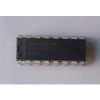Features: ` Low Average Current Consumption: 4.5mA (CDMA)
` +2.7V to +3.6V Operation
` 2.0dB Cascade GPS Noise Figure
` 2.5 dB Cascade CDMA Noise Figure
` Adjustable IIP3
` LO Output Buffer to Drive Tx Upconverter
` 1A Shutdown Current
` Tiny 2.1mm * 2.7mm Chip-Scale Package (UCSP™)
` Single VCO for GPS and CDMA Operation
` LO Divider Improves Phase Noise/DesensitizationApplicationCDMA/cdma2000 1x Cellular Phones with GPSSpecificationsVCC to GND...........................................................-0.3V to +4.3V
Digital Input Voltage to GND ........................-0.3V to VCC + 0.3V
RF Input Power ..............................................................+12dBm
Digital Input Current .......................................................±10mA
Continuous Power Dissipation
5 * 4 UCSP (TA = +70°C, derate 1.2mW/°C above
TA = +70°C) ............................................................995mW
Thermal Resistance from Junction to Ambient ............+80°C/W
Operating Temperature Range ......................-40°C to +85°C
Junction Temperature..................................................+150°C
Storage Temperature Range .......................-65°C to +150°C
Bump Temperature (Soldering) (Note 1)
Infrared (15s) .......................................................+220°C
Vapor Phase (60s) ................................................+215°C
Note 1: This device is constructed using a unique set of packaging techniques that impose a limit on the thermal profile the device can be exposed to during board level solder attach and rework. This limit permits only the use of the solder profiles recommended in the industry standard specification, JEDEC 020A, paragraph 7.6, Table 3 for IR/VPR and convection reflow.Preheating is required. Hand or wave soldering is not recommended.
Stresses beyond those listed under "Absolute Maximum Ratings" may cause permanent damage to the device. These are stress ratings only, and functional operation of the device at these or any other conditions beyond those indicated in the operational sections of the specifications is not implied. Exposure to absolute maximum rating conditions for extended periods may affect device reliability.
DescriptionThe MAX2385/MAX2386 LNA/mixer ICs are designed for CDMA/cdma2000 1x and GPS applications. The MAX2385/MAX2386 are optimized for the Japanese 832MHz to 870MHz band, and can also be configured for the Korean/Chinese/U.S. 869MHz to 894MHz band.To optimize linearity and current consumption, the CDMA LNA comprises four gain states. The high-gain LNA has a reduced supply-current mode for use when no transmit (Tx) signal is present, and a high linearity mode, which minimizes Tx cross-modulation in the presence of a large interfering signal during talk mode.Two low-gain modes, provide higher cascade IIP3 at lower current. The lowest gain setting provides an LNA bypass and an ultra-low chip current of 4mA. This significantly extends the phone's standby time and lowers the overall current consumption of the phone.
Gain-switching hysteresis can be adjusted by selection of an off-chip resistor, which sets the current and linearity in each mode to customize switchover points.In GPS mode, the MAX2386 LNA offers high gain and the MAX2385 features lower current consumption with lower gain. The CDMA paths of the MAX2385/MAX2386 are identical.
The MAX2385/MAX2386 include an on-chip LO divider,which enables the use of one VCO module for both cellular and GPS modes. An on-chip LO buffer to drive the Tx upconverter further reduces system complexity.

 MAX2386 Data Sheet
MAX2386 Data Sheet






